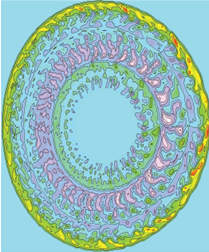Using radio waves to control the density in a fusion plasma

Recent fusion experiments on the DIII-D tokamak at General Atomics (San Diego) and the Alcator C-Mod tokamak at MIT (Cambridge, Massachusetts), show that beaming microwaves into the center of the plasma can be used to control the density in the center of the plasma, where a fusion reactor would produce most of its power. Several megawatts of microwaves mimic the way fusion reactions would supply heat to plasma electrons to keep the "fusion burn" going.
The new experiments reveal that turbulent density fluctuations in the inner core intensify when most of the heat goes to electrons instead of plasma ions, as would happen in the center of a self-sustaining fusion reaction. Supercomputer simulations closely reproduce the experiments, showing that the electrons become more turbulent as they are more strongly heated, and this transports both particles and heat out of the plasma.
"We are beginning to uncover the fundamental mechanisms that control the density, under conditions relevant to a real fusion reactor," says Dr. Darin Ernst, a physicist at the Massachusetts Institute of Technology, who led the experiments and simulations, together with co-leaders Dr. Keith Burrell (General Atomics), Dr. Walter Guttenfelder (Princeton Plasma Physics Laboratory), and Dr. Terry Rhodes (UCLA).
The experiments were conducted by a team of researchers as part of a National Fusion Science Campaign. This new program enables research on one fusion experiment to be expanded to device another with complementary instrumentation and capabilities. "The National Campaign has increased the impact of our work, with added benefit to the fusion program," says Dr. Ernst. "Comparing Alcator C-Mod and DIII-D tests our new predictions that particle collisions strongly reduce this type of turbulence. The collision rate varies by a factor of ten between the two machines," says Ernst.
The experiments and simulations suggest that trapped electron turbulence becomes more important under the conditions expected in self-heated fusion reactors. The structure of the simulated turbulence during the electron heating is shown at right. The simulations closely matched detailed measurements of the actual turbulence in the 20cm diameter inner core. "We discovered sheared flows also drive turbulence in the inner plasma core, but as we approached conditions where mainly the electrons are heated, the usual plasma flow is reduced and pure trapped electron turbulence begins to dominate," says Dr. Guttenfelder, who did the supercomputer simulations for the DIII-D experiments, along with Dr. Andris Dimits (LLNL). Measurements revealed a band of fluctuations, separated by a constant frequency interval, like harmonics in a musical note. "These new coherent fluctuations appear to be consistent with the basic trapped electron instability that grows stronger during heating, " says Dr. Rhodes.
In a self-heated fusion reactor, fusion reactions produce very energetic alpha particles that collide with electrons as they move through the plasma. The collisions heat the electrons by imparting random thermal motion. The electrons in turn collide with and heat cooler deuterium and tritium fuel ions to fusion temperatures. However, turbulent eddies can swirl the particles and energy away from the hot core toward the cooler edge, where they eventually are lost to the walls of the chamber.
These experiments are part of a larger systematic study of turbulent energy and particle loss under fusion-relevant conditions. "It's important to understand what drives the turbulence, and how it can be controlled and minimized, to find new ways of operating tokamaks that exploit that knowledge," says Dr. Burrell. By comparing detailed turbulence measurements with simulations, researchers hope to understand how turbulence controls the core temperature under fusion conditions.
More information: Abstract: CO5.00002 , Controlling DIII-D QH-Mode Particle and Electron Thermal Transport with ECH , Speaker: D. R. Ernst (MIT) 2:12 PM–2:24 PM, Monday, October 27, 2014, Galerie 2/3
Provided by American Physical Society




















